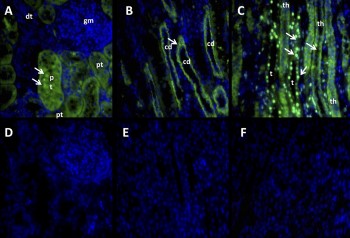Overview
- Peptide (C)KIRKNTWASHSSK, corresponding to amino acid residues 212-224 of the rat Angiotensin-(1-7) Mas receptor (Accession P12526). 3rd intracellular loop.
- Rat, mouse and human samples (1:200).
 Western blot analysis of rat brain (lanes 1 and 4) kidney (lanes 2 and 5) and heart (lanes 3 and 6) membranes:1-3. Anti-Angiotensin-(1-7) Mas Receptor Antibody (AAR-013), (1:200).
Western blot analysis of rat brain (lanes 1 and 4) kidney (lanes 2 and 5) and heart (lanes 3 and 6) membranes:1-3. Anti-Angiotensin-(1-7) Mas Receptor Antibody (AAR-013), (1:200).
4-6. Anti-Angiotensin-(1-7) Mas Receptor Antibody, preincubated with Angiotensin-(1-7) Mas Receptor Blocking Peptide (#BLP-AR013). Western blot analysis of mouse kidney membranes:1. Anti-Angiotensin-(1-7) Mas Receptor Antibody (AAR-013), (1:200).
Western blot analysis of mouse kidney membranes:1. Anti-Angiotensin-(1-7) Mas Receptor Antibody (AAR-013), (1:200).
2. Anti-Angiotensin-(1-7) Mas Receptor Antibody, preincubated with Angiotensin-(1-7) Mas Receptor Blocking Peptide (#BLP-AR013). Western blot analysis of human HeLa cervix adenocarcinoma cell line lysate:1. Anti-Angiotensin-(1-7) Mas Receptor Antibody (AAR-013),(1:200).
Western blot analysis of human HeLa cervix adenocarcinoma cell line lysate:1. Anti-Angiotensin-(1-7) Mas Receptor Antibody (AAR-013),(1:200).
2. Anti-Angiotensin-(1-7) Mas Receptor Antibody, preincubated with Angiotensin-(1-7) Mas Receptor Blocking Peptide (#BLP-AR013).
- Rat kidney sections (paraffin embedded) (1:100).
- Mouse microglia culture (1:20) (Foulquier, S. et al. (2019) Angiogenesis 22, 481.).
The Angiotensin-(1-7) Mas receptor is the recently identified receptor of the biologically active heptapeptide Angiotensin-(1-7).1
Angiotensin (Ang)-(1-7) is a metabolite of the well known peptide hormone Angiotensin (Ang) II, a key component of the renin-angiotensin system (RAS) that has a central role in cardiovascular homeostasis.
Considerably interest in Ang-(1-7) and its receptor aroused in the last few years since it became apparent that it can counterbalance most of Ang II effects. Thus Ang-(1-7) has vasodilator and hypotensive effects as well as antiarrhythmic and cardioprotective roles.2, 3
The Ang-(1-7) Mas receptor belongs to the 7-transmembrane domain, G protein-coupled receptor (GPCR) superfamily and was originally described as a protooncogene.
Signaling via the Ang-(1-7) Mas receptor is still poorly elucidated however, evidence indicates that the receptor is coupled to a Gq/11 protein that activates phospholipase C (PLC).2,3
The Ang-(1-7) Mas receptor is expressed in several organs including heart, kidney, blood vessels, testis and brain. Studies with Ang-(1-7) Mas receptor knockout mice have demonstrated the key role of this receptor in cardiovascular regulation as well as in the regulation of learning and memory.2
Application key:
Species reactivity key:

Expression of Angiotensin-(1-7) Mas Receptor in sheep kidney.Immunohistochemical staining of sheep kidney sections using Anti-Angiotensin-(1-7) Mas Receptor Antibody (#AAR-013). A. Mas receptor staining in the cortex (green) is mostly associated with the proximal tubules and is absent in in the glomerulus. B. Mas receptor staining is observed in the collecting ducts in the medullary region. C. The limb of Henle also shows Mas receptor staining. D-F. Mas receptor staining is abolished when the antibody is pre-incubated with the control peptide antigen.Adapted from Gwathmey, T.M. et al. (2010) Am. J. Physiol. 299, F983. with permission of The American Physiological Society.
